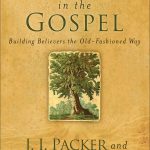One of the things I appreciate about Michael Horton is that he writes both for the academy and also the congregation. It’s a mark of a good theologian to do both well. Horton is a professor of apologetics and theology at Westminster Seminary California. Some of his outstanding titles include Putting Amazing Back Into Grace, People and Place, We Believe, and A Better Way. He is also the publisher of the indispensible monthly journal Modern Reformation and host of the White Horse Inn radio program.
This relatively slim volume was originally published with the title Too Good to Be True: Finding Hope in a World of Hype, which I rather liked. Zondervan has released it with a new title and a new cover, and I am glad that new attention is being given to this outstanding book.
A Place for Weakness: Preparing Yourself for Suffering is driven along by an unrelenting but refreshing realism. There are no false promises here. There are no clichés or newly discovered secrets for “living in victory.” Horton helps us understand suffering as unromantic but deeply purposeful. In other words, we do not have to pretend that suffering does not hurt and cause dismay. At the same time, we are confidently pointed to the mysterious comfort that everything that comes our way passes through the hands of our good and sovereign God. “The unity of God’s sovereignty and goodness that will be finally disclosed on the last day has already dawned decisively in the work of Christ” (45).
Horton defines “the bottom line of this book” in this way:
The gospel is good news for losers, that in fact we are all losers if we measure ourselves by God’s interpretation of reality rather than our own. The demand for glory, power, comfort, autonomy, health, and wealth creates a vicious cycle of craving and disillusionment. It even creates its own industry of therapists and exercise, style, and self-esteem gurus-and churches-to massage the egos wounded by this hedonism. When crisis hits, the soul is too effete to respond appropriately. We become prisoners of our own felt needs, which were inculcated in us in the first place by the very marketplace that promises a “fix.” We become victims of our own shallow hopes. We are too easily disappointed because we are too easily persuaded that the marketplace always has something that can make us happy (26).
A Place for Weakness is divided into two sections: 1) God of the cross and 2) God of the empty tomb. These two realities, the cross and resurrection of Christ, are the two most significant defining realities of life. It is in the crucified and risen Christ that we find our hope, not in the temporary cessation of pain or acquisition of wealth. “In the cross and resurrection, God does not explain the problem of evil to our satisfaction but actually overcomes it in a way that surprises and overwhelms us” (36).

A Place for Weakness: Preparing Yourself for Suffering
Michael Horton
In A Place for Weakness, formerly titled Too Good to Be True, Horton exposes the pop culture that sells Jesus like a product for health and happiness and reminds us that our lives often lead us on difficult routes we must follow by faith. This book offers a series of powerful readings that demonstrate how, through every type of earthly difficulty, our Father keeps his promises from Scripture and works all things together for our good.
I was approached not long ago by a congregant who told me with great enthusiasm that he had attended a rally by a well-known faith healer and purveyor of the prosperity “gospel.” As I challenged him on his poor choice to attend such an event it became clear that this man desperately wanted the promises of these modern charlatans to be true. But it is not only the flashy neo-Pentecostals who are peddling false promises of earthly comfort and prosperity. It is found in “softer” forms within the walls of more mainstream evangelical churches.
Through meticulous attention to Scripture and illustrations from his own experiences with pain in life and ministry, Horton helps the reader confront the false hopes of the strange, materialistic Gnosticism of contemporary evangelicalism. What is more he holds forth the beautiful and hope-filled realism of the cross and resurrection of Jesus.
Read this book. Read it if you are at all interested in understanding how the doing, dying, and rising of Christ answers your sufferings. Read it if you are at all interested in how the gospel hushes the law’s loud thunder. Read it to learn how eternal hope is even better than explanations about why we suffer at any given time. Read it if you are a pastor so you can be better equipped to help your suffering parishioners see their lives in relation to the defining reality of the Good News.




































